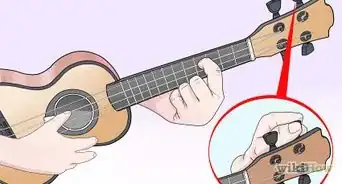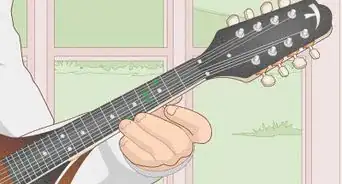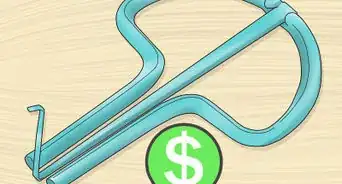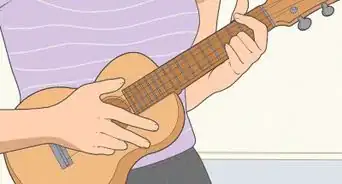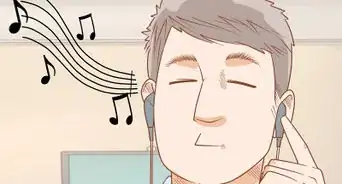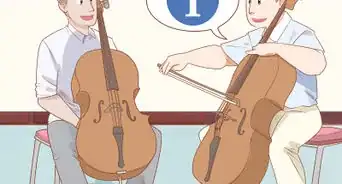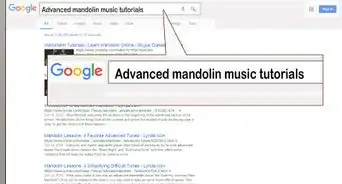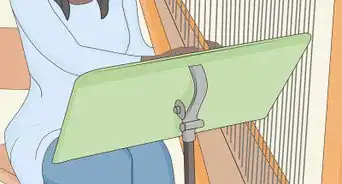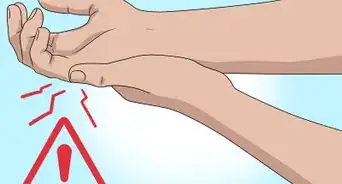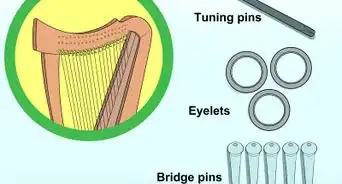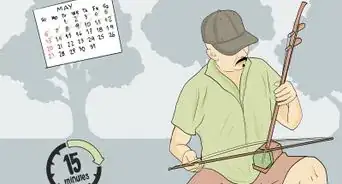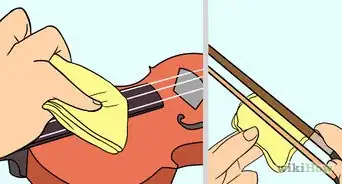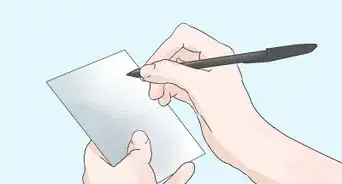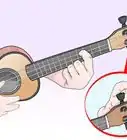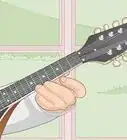wikiHow is a “wiki,” similar to Wikipedia, which means that many of our articles are co-written by multiple authors. To create this article, 11 people, some anonymous, worked to edit and improve it over time.
There are 8 references cited in this article, which can be found at the bottom of the page.
This article has been viewed 29,442 times.
Learn more...
The guzheng is an incredibly unique and interesting instrument to play. Many people like the sound of a guzheng because it can be soothing and relaxing. If you have access to a guzheng, this wikiHow will teach you the basics and how to get a great sound out of it.
Steps
Learning the Basics
-
1Understand the structure of the guzheng.[1] You should see two sides of the guzheng: the right and left sides. You should have 21 bridges for each of the 21 strings.
- The box on the rightmost part of the guzheng can be opened and is usually used to store essentials, such as artificial nails and tuners. The box is usually called the head.
- There should be wood holding up your guzheng. You can adjust these to fit your height.
- On the far left, there is something called an "S-bridge." These are the holes where the strings travel down. The "S-bridge" is just to the tail's right, which is the farthest left part.
- All of the wood between the head and the S-bridge is the soundboard.
-
2Learn how to put on your artificial nails. Guzheng players will need artificial long nails so they can play the strings. The nails are usually a brown-white marble color. For beginners, you'll usually need 4 of them, including the special one for the thumb. You can get these at a Chinese instrument shop.
- Get the tape. The tape comes in many colours and is used to stick the nails to the fingers. You'll need about 8 to 10 centimeters (3 to 4 in) of tape for each nail.
- Stick one end of the tape to the nail.
- Put the nail before your first joint on the soft part of your finger and wrap the tape around the finger.[2]
- You should have about 2.5 loops. If you don't, you may need to get more/less tape to fit your finger.
- Test the nail on the guzheng to see if it works by plucking a string.
- Use the above steps for the middle, index, and ring fingers.
- For the thumb, follow the same steps, except you should turn the nail at a 45-degree angle.
- You'll need to get new tape once every week or so, as sweat and other things cause it to be less sticky.
- As you get later into your studies, you'll also need tape and nails for your left hand.
Advertisement -
3Learn the basics of plucking the strings of the guzheng. When plucking the strings, you shouldn't emphasize your wrist, but instead, you should use your fingers to pluck the strings. Practice moving your fingers into a curve, then back up.[3] These are the basic techniques for plucking:
- To pluck the string with your thumb, position your thumb at a place where it will be able to make a sound out of the string. If you put on your nail correctly, the thumb should be able to pluck the string. Remember not to move your whole hand, but just the thumb's joint.
- The name for the thumb's plucking is "tuo." In music, its symbol is a shape of a right angle.
- To pluck the string with your index finger, tuck all the other fingers in your palm. Use your index finger to pluck the string, and during that, quickly move it so it aligns with the other fingers in the palm.
- The name for the index finger's plucking is "mo." Its symbol is a slash.
- Pluck the string with your middle finger. Do the same as you would with the index finger, except using the middle finger.
- The name for the middle finger is "gou." Its symbol is a rainbow-like shape.
- Try using your ring finger to pluck. Only do this when you have mastered the other three. Pluck it the same way as your index finger.
- This is called "da." A mountain-like structure represents it.
- During, before, and after plucking, your other fingers should be curved in your hand.
- Sometimes when playing a very fast-paced song, you might need to keep the fingers close to the strings to pluck them quickly. In the beginning, you don't need to worry about this, though.
- You can also connect notes. Instead of playing just one individual note for each note, you can play multiple notes, lifting and plucking the last note of the sequence. The note's finger denotes it for the first note, and hyphens on top of the other notes. Make sure to lift and pluck for the last hyphen you see.
Tip: When plucking and playing songs, make sure you position your hand on the right part of the guzheng (to the right of the bridges, which are the pieces of wood holding the strings up). The left side of the strings is usually only plucked for dramatic sound effects and doesn't produce musical tones.
- To pluck the string with your thumb, position your thumb at a place where it will be able to make a sound out of the string. If you put on your nail correctly, the thumb should be able to pluck the string. Remember not to move your whole hand, but just the thumb's joint.
-
4Understand how to tune your guzheng. To tune your guzheng, open the box on the right end of the guzheng. There should be many little silver rod-shaped keys. To do the steps below to tune it, you should have a tuner to check your notes and a lever to adjust the strings. If you don't have a tuner on you, you can find an app or online website to tune your guzheng.
- Play a note on your guzheng while the tuner is on. If the tuner indicates that your note is correct, go to the next note.
- If the note is too flat, the string needs tightening. To do this, get your lever and position it on the corresponding silver key to the note. Push it forward a bit. Then recheck it, then repeat.
- If the note is too sharp, it needs to be looser. Do the opposite of the above: push it back to loosen the string.
- Repeat for all strings.
-
5Learn to read the notes. In guzheng music (Jian Pu), there are only 5 notes: 1, 2, 3, 5, and 6. 4 and 7 can be made by manipulating the strings, but the basic five are the pentatonic scale.
- Beginners will usually start using D major. This is denoted by "1=D" on top of the music.
- The numbers represent each note. For example, in D major, 1 would be D, 2 would be E, 3 would be #F, etc.
- To understand which note is which, find the green strings on your guzheng. Every green string represents an octave. In D major, every green string is 5.
- Counting down from the green string, the notes are 3 and 2.
- Counting towards you from the green string, the notes are 6 and 1.
- Next, you'll need to learn the octaves of Chinese music. The highest note, 1, on the guzheng, is the string that is closest to you. The lowest note, also 1, is the string that is furthest away from you. The highest 1 will have 2 dots above it in sheet music. The lowest 1 will have 2 dots below it in sheet music.
- The second note that is most towards you is 6. It will have only 1 dot above it.
- The second note that is farthest from you will be 2. It will have 2 dots below it in Chinese music.
- Note that you will try G and A scales when you get more advanced, where "1=G" or "1=A," respectively. It can be done by manipulating the wooden blocks or tuning to a different note. In G major, every green string is 2, and the topmost/bottommost note is 5.
-
6Understand how to read rhythm. Guzheng music uses lines below the numbers.
- Notes without any lines below them are worth 2 beats. They have a hyphen-looking character to the right of them. If there are two hyphens to the right, it's worth 4 beats.
- Notes without any lines below them without the hyphen are worth 1 beat.
- Notes with one line below them are worth half a beat.
- Notes with two lines below them are worth 1/4 of a beat.
- Notes with three lines below them are worth 1/8 of a beat.
- Notes with a dot to the right can be worth 1.5 beats or 3/4 of a beat. If the note has one line below it and a dot, it's worth 3/4 of a beat. If there isn't a line below it and it has a dot, it's worth 1.5 beats.
-
7Play a simple song. There are many simple songs you can find on the internet, so try one!
- Go for songs with a simple rhythm, as those are easier for beginners.
- Don't play something like "Twinkle Twinkle Little Star" as that requires a 4. Since it requires more technique to play 4 on the guzheng, it's best if you don't try as a beginner. Learning to pluck and getting basic knowledge of the strings are the top priorities.
Learning Intermediate Techniques
-
1Try doing a glissando. A glissando is when you start at one string then quickly move the hand to pluck every single string until you stop at another string. It is similar to a piano glissando but is done vertically.
- When doing a glissando with your thumb, shift the other parts of your hand forward.
- This motion is denoted by a star shape when you need to do a glissando with your thumb (often to a note). It can also be denoted as a normal piano glissando shape with the direction you're going.
- If a glissando is right before a note, it can be denoted as a star shape with two lines below it, just to the left of a note. When playing these, the glissando is played using your thumb and is going the direction away from you. Make it fast to stay on beat!
- Glissandos don't have to start from the top of the guzheng.
-
2Try plucking away from your palm. This is the opposite of basic plucking. This takes practice, but the result is worth it!
- Start by doing this with your thumb, then move on to other fingers.
- This can be done by any finger, though the pinky rarely does it.
- The notation for this will be the opposite of the notation for normal plucking with that finger. For example, for the thumb, the normal notation is a right angle. For plucking away, it'll be rotated 180 degrees.
- The term for plucking away from your palm with your thumb is called "pi."
-
3Play some chords. Using your right hand, use your thumb and another finger to play a chord (two notes together).
- There are 2 forms of this—playing a chord with your index and thumb, or with your middle finger and thumb.
- For 2 notes with less than 4 other notes between them, use your index and thumb.
- For 2 notes that have 4 or more, use your middle finger.
- In extreme cases when the distance between the two notes is very large, you use the thumb and ring finger. Sometimes the left hand can play the other note.
- Make sure not to touch other keys when playing the chord.
- This will be denoted by two notes on top of each other. Play the two notes you see.
- Chords can also be done with 3 fingers or 4 fingers.
- Don't let your nails come in contact with each other after playing the chord; otherwise, your nails will collide and hit each other.
-
4Incorporate your left hand. Here are a couple of ways you can do this:
- Remember that to press down on a string, use your index, middle, and ring fingers. Use your fingertips. This also works if you have nails on.
- Before playing the note 3, press down on the string on the other side of the guzheng (to the left of the bridges). The note played will be a 4.
- To play 7, pluck the note 6 while pressing down on the other side.
- Use your left hand on the right side to play notes. When a piece of music wants you to do this, it'll have two "sections" for right and left hands, just like in western notation.
- Right after playing any note, lightly press down and wiggle your wrist on the corresponding string on the left side to do vibrato. A squiggly line denotes this on top of a note. If you see a squiggly line on top of a chord, you should do this effect on the top note. You can also press down heavily to create a stronger effect.
- After plucking a note on the right side, press down on the left side. For example, after plucking 3, you can press down on the left side to "glide" to a 4. An arrow denotes this from one note to the next. It can also be denoted as an arrow pointing up. This is called a portamento.[4]
- Try doing the same as above, except backward. Press down on any note, play it, then let go. An arrow can also denote this to the next note, or an arrow pointing down.
- Try sweeping. Use your nails on the left hand (it may help to put on artificial nails) and sweep your nails on the right side's lower strings. It should create a banging noise. A screwdriver-like symbol denotes this. You can also do sweeping after a glissando using your thumb to push the end of the guzheng.
-
5Try doing arpeggios.[5] This technique is an essential one and is used in various songs.
- You can do this with your left hand or right hand.
- Find the notes you want to do the arpeggio on. Usually, it'll be 4 notes, but there are arpeggios with 3 notes or two notes in rare cases.
- Place your fingers so they're ready to play the notes. When the arpeggio is 4 notes, the 4 fingers are your ring finger, middle finger, index finger, and thumb. When it's 3 notes, the 3 fingers are your middle finger, index finger, and thumb. Don't play it just yet.
- Pluck the strings, starting from the string farthest away from you.
- Keep on plucking until all the strings are plucked.
- Remember to move your fingers in after plucking!
- This is denoted by a vertical squiggly line with the 4 (or 3) notes to the squiggly line's right.
-
6Play harmonics.[6] These are notes that sound like bells and an octave higher than what is expected from that note. They are softer than normal plucking.
- This is denoted by a circle on top of a note.
- Move your left hand to the right side of the guzheng.
- Find the note you want to play.
- Locate the approximate midpoint from where the string starts at the head to the string's bridge and put your left pinky on the midpoint.
- Play the note using your right hand (positioning your right hand to the right of your left hand).
- Just after you play the note, lift your pinky.
- If you get a sound like wood clanking, make sure your pinky is correctly positioned. Try lower notes first, as those are easier and have more wiggle room for the pinky.
-
7Learn the "finger shake."[7] This technique requires a lot of practice and is used to replace long notes. Since long notes can't be played easily with the guzheng, the finger shake is an essential thing to learn.
- The finger shake is denoted by three straight lines at a 45-degree angle to the right of a note.
- Put your hand in the finger shake position. Put the side of your index finger on the tape of your thumb. Relax the other fingers of your hand, and straighten your pinkie.
- Find the string you want to hold a long note on and place your straightened pinkie outside the strings on the side. Put it at a comfortable distance. Usually, it's one or two strings counting from the note away from you.
- Put your elbow up and wrist down (this will help you do the finger shake easily).
- Start the finger shake. Pretend you're waving goodbye, and twist your wrist towards you, playing your desired note with your thumb (remember that this is called pi!). Then, twist in the other direction away from you (tuo). Your elbow should remain relatively still. You'll have to go slowly and gradually make your way to a continuous note.
- Keep on twisting your wrist front and back to pluck the note with your thumb.
- Practice this until your speed increases.
- This is a hard skill to master, so you'll need a lot of practice to get it right.
- Remember to relax your hand.
- You can add modifications to the finger shake. For example, you could let go of your pinky and shake it in thin air, and/or use your other 2 fingers (middle and ring) to sweep the strings farther away from the note you're holding. Remember to master the basic way first, though.
-
8Improve the looks of your playing. This will allow your playing to seem more elegant and beautiful.
- When playing a long note (2 beats), raise your hand after playing the note, slowly drop it, and get ready for the next note.
- When playing a note that's supposed to sound soft, position your hands towards the left side of the tuned side of the guzheng. When playing a louder note, position your hands towards the right (head).
- When playing a glissando from the last note to the first note towards you, lift your hand at the glissando's end.
- When your right hand and left hand are about to play together, lift them simultaneously.
Community Q&A
-
QuestionIf you naturally have long nails, do you need to have fake ones?
 Community AnswerYes. Using your own nails to pluck the strings of the guzheng can cause harm to them, as they will wear over time. Using the fake ones is mandatory.
Community AnswerYes. Using your own nails to pluck the strings of the guzheng can cause harm to them, as they will wear over time. Using the fake ones is mandatory. -
QuestionWhere would be best to buy the guzheng?
 Community AnswerThere are a lot of stores that sell the guzheng. You can search for Chinese instrument stores in your area. Most of these stores will definitely have the guzheng. You can also find a teacher to buy one from.
Community AnswerThere are a lot of stores that sell the guzheng. You can search for Chinese instrument stores in your area. Most of these stores will definitely have the guzheng. You can also find a teacher to buy one from. -
QuestionWhy does the guzheng have 22 strings?
 Community AnswerThe guzheng actually has 21 strings. They are of a different width and produce different tones.
Community AnswerThe guzheng actually has 21 strings. They are of a different width and produce different tones.
Warnings
- When tuning your guzheng, don't tighten it too much, or you can risk breaking one of the strings.⧼thumbs_response⧽
Things You'll Need
- Working guzheng
- Artificial nails
- Special tape
- Sheet music
- Tuner
- Teacher (optional)
References
- ↑ https://guzhengalive.com/guzheng-terminology
- ↑ https://exotic-instruments.wonderhowto.com/how-to/attach-guzheng-nails-onto-your-fingers-295535/
- ↑ https://guzhengalive.com/guzheng-techniques
- ↑ https://guzhengalive.com/guzheng-techniques#portamento-single
- ↑ https://guzhengalive.com/guzheng-techniques#arpeggios
- ↑ https://guzhengalive.com/guzheng-techniques#special
- ↑ https://guzhengalive.com/guzheng-techniques#tremolo
- https://www.easonmusicschool.com/jianpu-101-how-to-read-numeric-scores/
About This Article
To play the guzheng, start by putting artificial nails on your thumb, index finger, middle finger, and ring finger. Stick one end of the tape to an artificial nail, position the artificial nail on the soft part of your finger, and wrap the tape around your finger about two to three times. Next, learn how to pluck the strings. Keep all of your fingers tucked in except for the finger plucking the string. Pluck the string using your whole finger while tucking it into your palm, aligning it with your other fingers. To pluck the string with your thumb, move your thumb so that it forms a 90-degree angle. To learn about more advanced techniques, scroll down!
-Step-1-Version-2.webp)
-Step-1.webp)
-Step-2.webp)
-Step-4-Version-2.webp)
-Step-4.webp)
-Step-6-Version-2.webp)
-Step-5.webp)
-Step-6.webp)
-Step-7.webp)
-Step-8.webp)
-Step-10.webp)
-Step-12.webp)
-Step-13.webp)
-Step-9-Version-2.webp)
-Step-11.webp)
